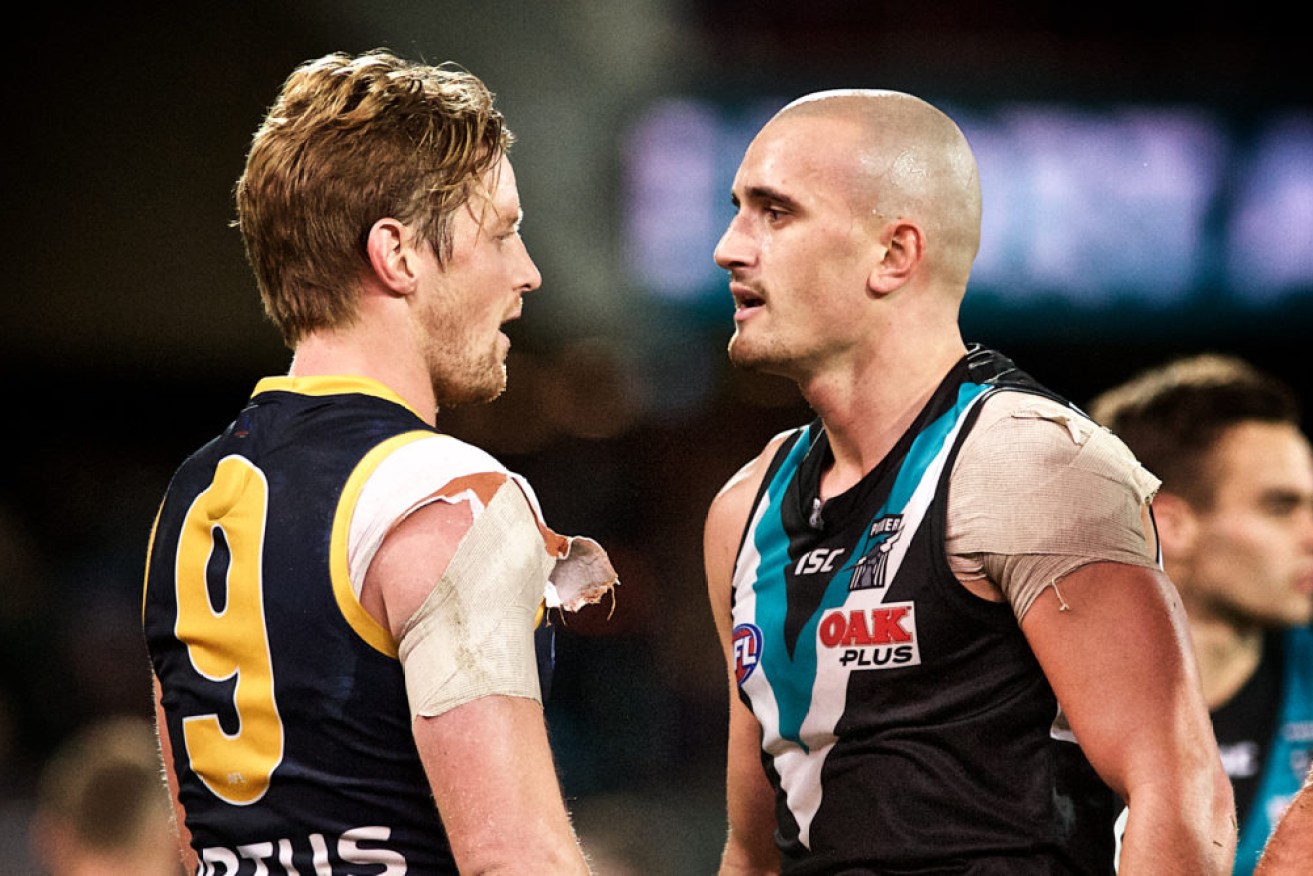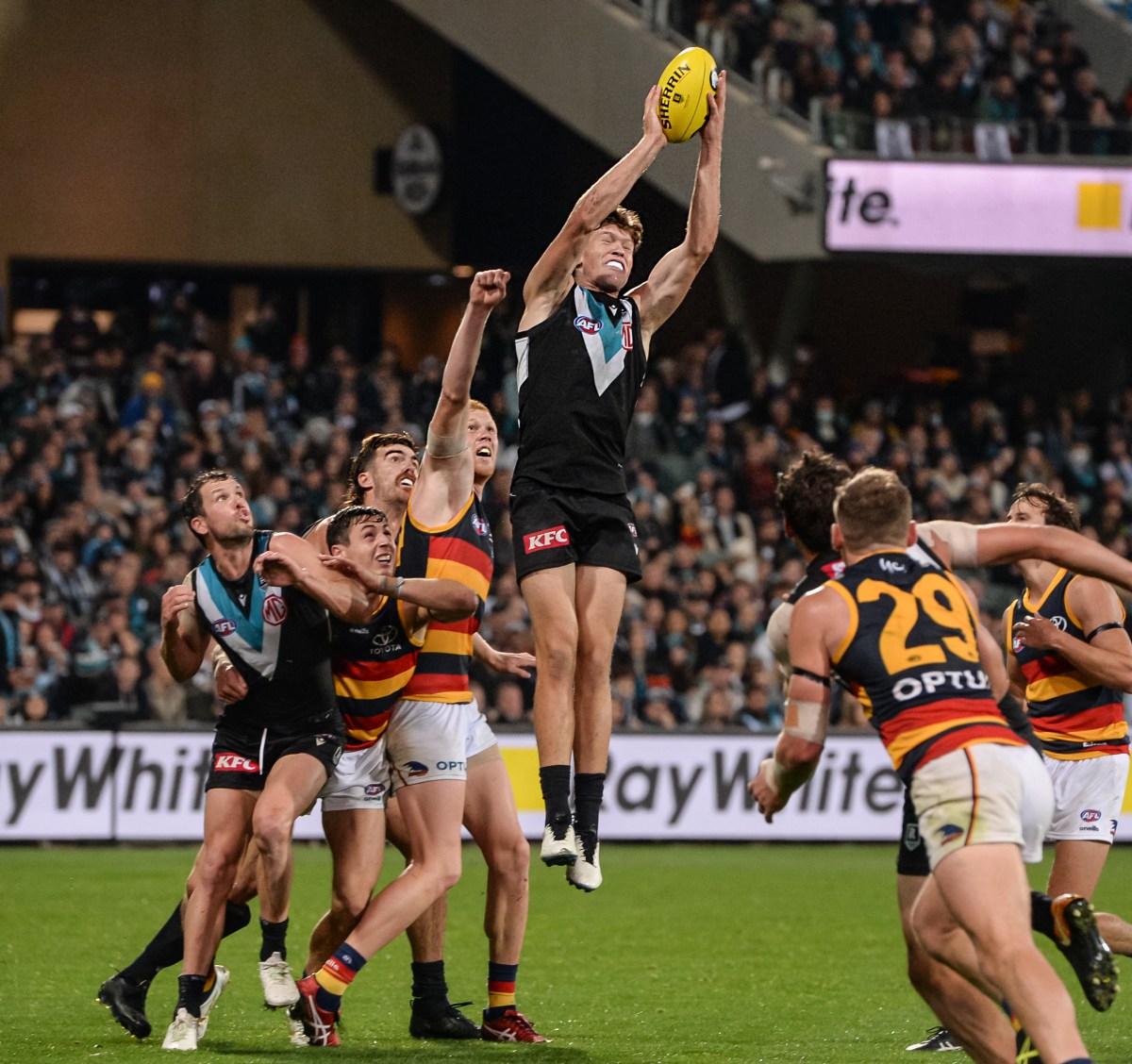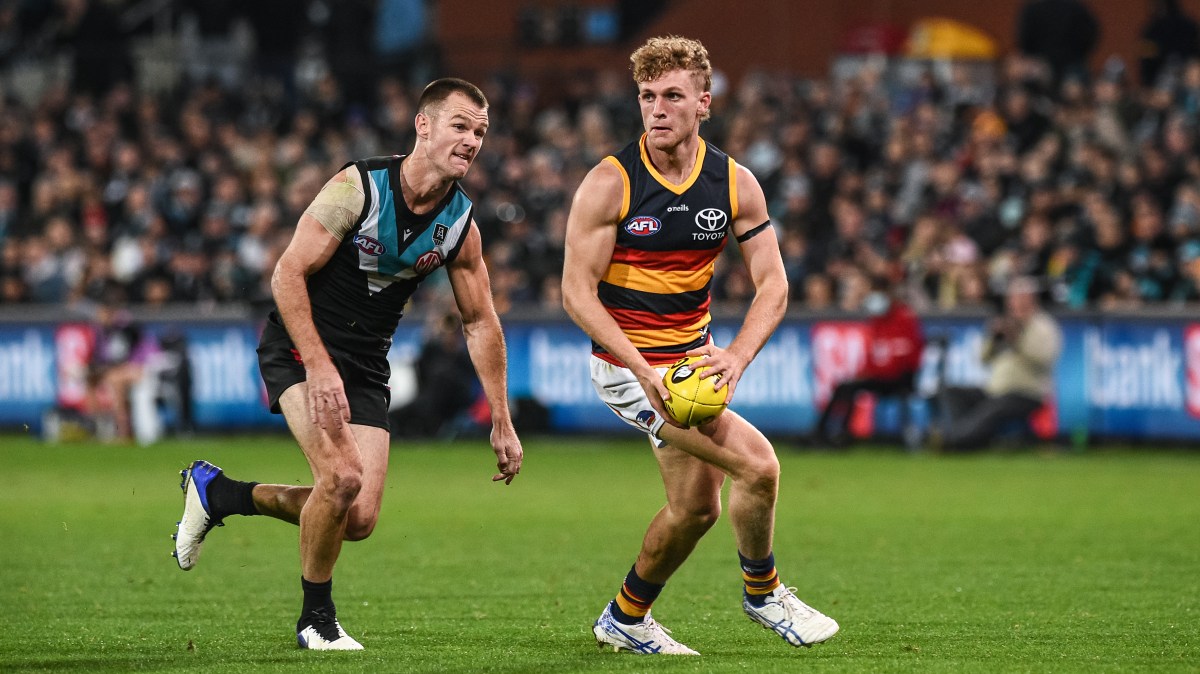Culture war: getting the lowdown on Showdown
Tomorrow, the Adelaide and Port Adelaide football clubs meet for a landmark 50th clash. After decades of on and off-field battle, what does South Australia’s greatest modern rivalry represent? Michelangelo Rucci reports.

Adelaide's Rory Sloane faces off against Port's Sam Powell-Pepper in a 2019 Showdown. The club rivalry makes the Showdown the best derby in the AFL, says Malcolm Blight. Photo: Michael Errey/InDaily
When SA Brewing executive Rob Chard engaged Sydney-based marketing agent Mike De Silva to come up with a “brand” for the AFL’s newest derby in Adelaide in 1997, the brief was clear cut.
“The name of the game had to become part of the vernacular of our city and our state,” says former brewery promotions executive Robbi Tims. “It had to be about two warring parties, of two teams going into battle like cowboys and Indians facing each other on hilltops ready to fight in the valley between them.
“It had to be a strong name.”
Showdown.
They even gave it Roman numerals to “show the continuity of the Showdown clashes” as done with American football’s annual Super Bowl. Today, the ancient tone of the numerals presents the contest as a duel that dates back many generations, rather than just from 1990 when the Adelaide Football Club was formed to cut off Port Adelaide at the entry to the expanding VFL that is today’s 18-team national AFL competition.
Rejecting “Southern Derby”, South Australian De Silva recommended Showdown saying: “We’ve created a Western feel to the theme emulating the showdown between the Earps, Doc Holliday and the Clantons at OK Corral ending a long stand-off period between the law and the outlaw, or The Good, The Bad and The Ugly theme.”
The Showdown brand even outlived SA Brewing’s sponsorship of the two AFL clubs and the derby that reaches its 50th edition on Saturday night at Adelaide Oval.
Port Adelaide won the first Showdown at Football Park on April 20, 1997 when famed artist Pro Hart set up his easel to capture the image of a Crows forward taking a shot on the southern goal at West Lakes.
Port Adelaide leads the Showdown ledger 25-24, and while the location for the derby has changed from Football Park to Adelaide Oval, the intense rivalry developed throughout the 1990s, on and off the football field, has not waned.

Showdown 49. Photo: Michael Errey/InDaily
So what does this Showdown rivalry, described by Malcolm Blight as the best in the AFL era of Australian football, mean to South Australia today? More so when neither club has men or women – and certainly not players – who have any personal scars from the tumultuous winter of 1990.
“It is still about bragging rights, isn’t it?” says Port Adelaide chief executive Matthew Richardson. “It is built on more than football; it is about the cultural divide that goes back to our SANFL days of Port Adelaide standing up for the working class against the white-collar crowd. In the AFL, it is still about wharfies against bankers.
“That stood out when (Port Adelaide football chief) Chris Davies put it so eloquently to (former Crows rover and now FIVEaa sports show host) Stephen Rowe to answer what separates the clubs – the cultural divide. Didn’t that ruffle a few feathers?”
Davies certainly kept the fires of angst raging between the neighbouring clubs – the teams’ training bases are both in Adelaide’s western suburbs – by saying: “The Crows’ position is largely around being in-town rivals and a whole heap of professional jealousy around what our club has been able to achieve over time; whereas our meaning for disliking the Adelaide footy club is a little bit deeper.
“And that is largely my responsibility in this week, is to make sure that our players get an understanding of … why we dislike Adelaide.”
While the Showdown rivalry is just 24-years old on the field, the derby has a foundation that sits as deeply as the Collingwood-Carlton classic in inner Melbourne that dates to 1892. Port Adelaide v Crows also is Port Adelaide v SA football from the pre-AFL era of South Australian football from 1877-1990.
One leading South Australian football identity who served the SANFL during the battle to establish a national league during the 1980s today wishes the Showdown was a continuation of the Port Adelaide-Norwood rivalry from 1878.
By 1893 this SANFL derby was being described in the way Showdowns are today: “Just as the more faithful amongst the tribes of the East feel it incumbent on them to pay a periodical visit to Mecca, so do lovers of the king of winter games feel it almost an essential duty on their part to journey to the Adelaide Oval on the Queen’s Accession Day, in sunshine or rain, to witness a trial of strength between those great and old rivals the Port Adelaide and Norwood clubs.”
The similarities do not end there. The Showdown is often referenced for the brawl between Port Adelaide and Crows players at the Ramsgate Hotel at Henley the day after a derby at Football Park early in the 2002 AFL season. In 1884, Norwood captain Alfred Waldron and Port Adelaide goalsneak Rob Roy and four of his team-mates finished in the city lock up and in the police courts after a post-match drink at the now-lost Imperial Hotel on Grenfell Street turned into a pub brawl.
More than a century later, the Showdown – just as Chard anticipated in his marketing brief on the derby – demands football fans make up their mind as to where they stand in the great divide.

Showdown 49. Photo by Michael Errey/InDaily
Famed broadcaster, Western Australian Dennis Cometti, saw the first and last Showdowns at Football Park. He remembers how the inaugural derby in 1997 ended with choices to be made by those Port Adelaide fans who supported the Crows as the lone South Australian entry in the AFL from 1991-1996.
“There were a few chameleons in the crowd (of 47,256); I think a few changed during the course of the game,” Cometti said. “They found their roots.”
Richardson struggles with the concept, once adopted and then dropped by former politician Christopher Pyne, of barracking for either South Australian club once there is a battle with a Victorian-based rival.
“Barrack for both clubs because they are South Australian? As if!” Richardson said. “Did you see the Scots barrack for England in the Euro championships because they were the last British team standing?”
Sam Jacobs played in 15 Showdowns during his 184-game career with the Crows from 2011-2019, after meeting with Port Adelaide at the end of the 2010 AFL season when he planned a homecoming move from Carlton.
The Showdown Medal-winning ruckman has played and lived through three intense rivalries in Australian football in three States: Collingwood-Carlton in Victoria, Port Adelaide-Crows in South Australia and the AFL’s newest rivalry, the “Battle of the Bridge” between Sydney and Greater Western Sydney in New South Wales.
“Collingwood-Carlton is rich in history, and you become engulfed in that traditional rivalry while 80,000 fans fill the MCG,” said Jacobs, the No.1 pick in the 2007 AFL rookie draft.
“But the fall-out of the match is never as big as the Showdown. There is always another big derby to follow against Essendon or Richmond.
“GWS-Sydney is developing because there is no shortage of hatred between the teams. The Giants have twice beaten Sydney in finals (in 2016 and 2018). There is a stark difference in the images of the two clubs – Sydney is prestigious and GWS is from the working class west. Sound familiar?
“That rivalry is real and it is going to help grow Australian football in Sydney.
“And the Showdown is about deciding where you want to stand in South Australian football. You are either with Port Adelaide or the Crows. You can’t have it both ways. You choose.
“I came from a home where my dad barracked for Sturt, so we grew up not liking Port Adelaide. But I do love what Port Adelaide has done and I do respect their history in the game.
“The two clubs are different. I don’t think it is a rivalry that needs to be built on hate. It should be about the differences we see in the two clubs and understanding what those differences do for South Australian football. That is the beauty of the Showdown. And you do need two great teams to create the show.”
Jacobs thrived on the build-up to a Showdown.
“I loved it,” he said. “Showdowns enables the players to have two finals-like games every year. The excitement, the buzz the Showdown generates around town is rare. It was my favourite game of the year. And knowing what came with losing helped to drive that energy in a Showdown – that is why I am proud to have a winning record in Showdowns.”
Jacobs joined Adelaide in 2011 after Port Adelaide coach and former ruckman Matthew Primus declared there was no room for another ruckman at Alberton alongside Matt Lobbe and Fabian Deluca. But how would have the Jacobs’ family coped had Primus made a different call?
“They would have come too, just as Brodie Smith has brought his Port Adelaide-mad family to the Adelaide Football Club,” Jacobs said. “At first it would be a bit weird, but you ultimately invest your emotions in your new club.”
This rings true even with Victorian draftees at both South Australian clubs, even those born after the 1990 rumble for the first Adelaide-based licence and without any knowledge of the “them versus us” divide between Port Adelaide and the SANFL clubs.
Discarding the “one week at a time” theme embraced by AFL teams, Victorian-born Port Adelaide wingman Xavier Duursma last week looked beyond his upcoming clash with Greater Western Sydney to say of the Showdown: “We want to make sure we sweep the Crows (by winning both derbies) which we would all enjoy doing.”
There are big repercussions at the end of a Showdown
Port Adelaide won Showdown 49 by 49 points on May 8. Since 1997, each club has swept its rival five times – Port Adelaide winning all multiple derbies in 2001, 2002, 2003, 2010 and 2013; Adelaide in 2005 (including the only final between the clubs), 2007, 2012, 2016 and 2017.
At West Lakes, Crows defender Daniel Talia grew up in Melbourne with the Collingwood-Carlton matches being the most-anticipated on the AFL fixture. And then in 1997 live television showed them Showdown I.
“Showdowns always was massive,” said Talia of his childhood memories. “The physicality and brutal way of the game, especially through the 1990s, was one you would look for. They were always classic games. You would always keep an eye on it, even from Melbourne.
“It was there with the big four (rivalries) of Melbourne with Collingwood, Carlton, Richmond and Essendon. You always looked for the Showdown as well.
“It was always brutal. Both teams were so tough – and stacked with class. It always was awesome to watch. You loved it as a kid.
“As a player, it is a game where you can really stamp yourself in the state and earn a lot of respect by performing in a Showdown. Both clubs and their players know that this game is so finals-like. If you can play well in a Showdown, with all the pressure and build up, it sets you up.
“And there is pride on the line. If you win, people come up to you for the week celebrating. If you lose, particularly in a bad fashion, it can be a real soul-searching exercise as well. There are big repercussions at the end of a Showdown.”
Crows forward Lachie Murphy was born in December 1998 after four Showdowns were played and grew up in Victoria while the AFL was developing two new rivalries in Adelaide and Perth. The South Australian derby captured his attention more than the West Coast-Fremantle Western Derby.
“And now it means everything to me,” said Murphy who has played in five Showdowns. “Coming from Victoria, I remember as a kid watching it, seeing a packed house and how much it meant to both sides. Now that I am a part of it, the whole week is quite special. To play in a few has been amazing. The anticipation, the build up – especially through some tough times for a lot of people in this state – hopefully, we can make some people feel better with a game of football.”
So what is this Showdown on the eve of its 50th rendition?
It is a football match that divides a state along clearly defined lines to the point of separating families. It is an AFL game that captures attention beyond South Australian borders. It is a rivalry that has endured animosity between the two clubs – and found a truce only once, in 2015 to honour the late Phil Walsh who died while serving as Crows coach and had a long tenure at Port Adelaide as an assistant coach.
It is a derby that still needs to complete its past by awarding retrospective Showdown Medals to the best players in the first six matches. Port Adelaide 1997 club champion Darren Mead now jests his Showdown Medal from the first derby will conferred posthumously.
It is a rivalry awaiting its female version while Port Adelaide is without an AFLW licence.
It is a Showdown.




